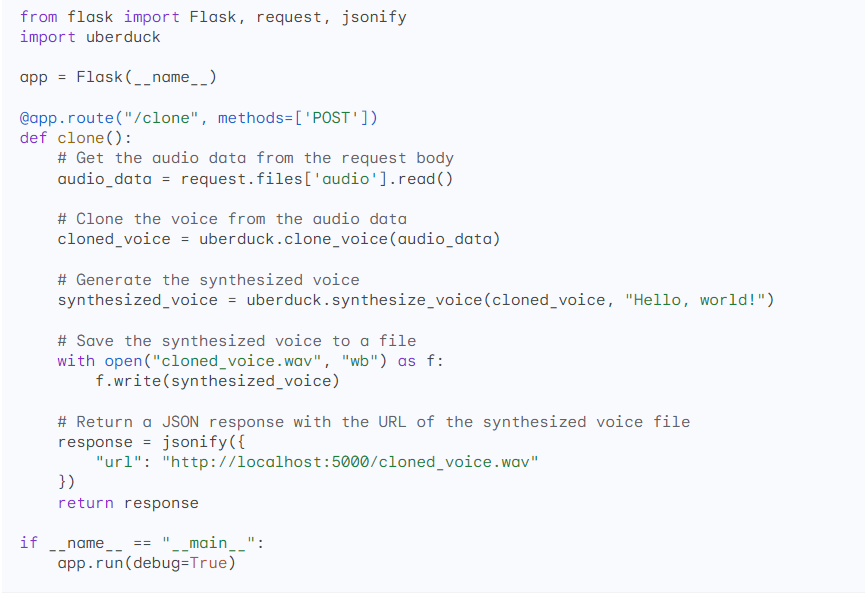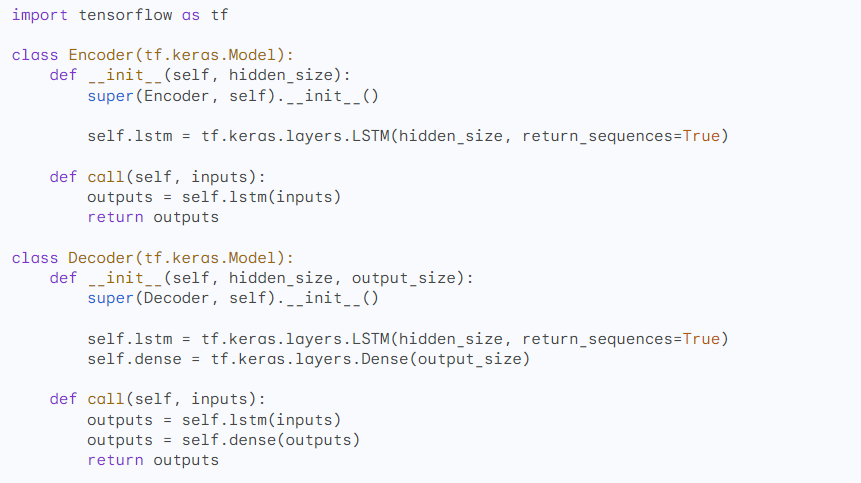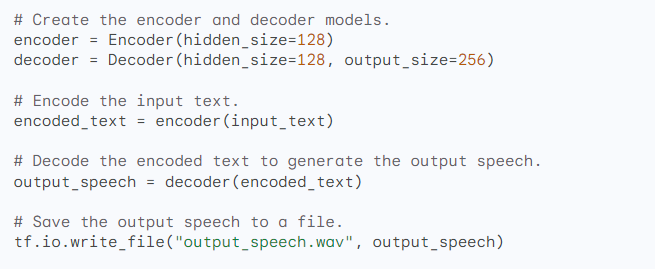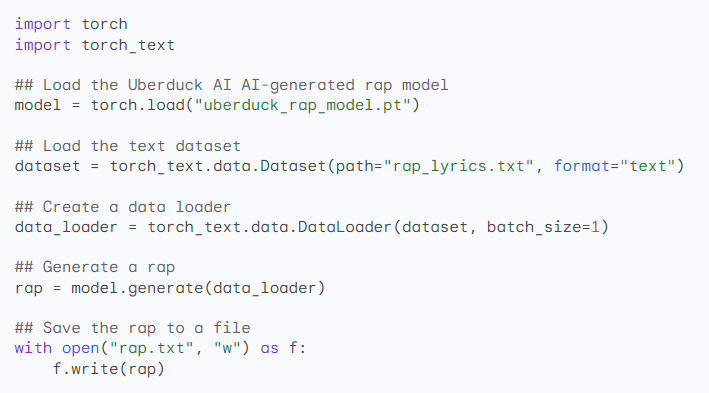UBERDUCK AI
Uberduck AI is an innovative artificial intelligence voice cloning platform designed to develop high-quality voiceovers, music and audio content. With more than 5000 expressive voices, Uberduck AI tool helps users to develop audio applications quickly and play around with different voices of celebrities, cartoon characters, musical pieces or custom voice assistants. Voices such as Peter’s Griffin from Family Guy or Walter’s White from Breaking Bad, are just a few from a large audio library available which you can choose from. Within moments, your audio track is ready to be downloaded and enjoy listening to it.
Brief Description:
Uberduck AI is a text-to-speech (TTS) and voice-to-voice (VTV) service that uses artificial intelligence to generate high-quality synthetic speech using natural language processing (NLP) and machine learning algorithms that provide customized natural-sounding voices. Able to convert text into speech and clone voices, Uberduck AI can create voices for customer support services or voice assistance chatbots, generate text such as lyrics, poems, code, scripts, musicals, dialogues and many more. Organizations and companies across the world can also benefit from using text-to-speech technology to extract valuable insights from their data, optimize processes and increase productivity.
Officially launched in 2020 by founder Zach Wener, Uberduck AI reached over 100 million views across social media and has already a growing community on Discord of over 14 000 users.
Architecture:
Uberduck AI voice generator platform uses machine learning algorithms to convert text into speech. The architecture of Uberduck AI consists of transformer models, vocoder, an API and web interface.
Transformer models are a type of neural network architecture, based on a self-attention mechanism, which allows them to learn from sequential data. Transformer models have two main components: an encoder and a decoder. Examples of transformer models: GPT-3, LaMDA, T5, BERT.
Encoder: The encoder transformer model is a convolutional neural network (CNN) responsible for taking a text input and produces a latent representation of that text, meaning the text is represented in a way that’s suitable for speech. The encoder handles tasks such as extracting data from a text sequence.
Decoder: The decoder transformer model is a type of a recurrent neural network (RNN) responsible for taking the latent representation of the text and produces a sequence of mel spectrograms. Mel spectrograms are a representation of the audio like TTS (text-to-speech), generating sequential data.
Vocoder: The vocoder is an algorithm that can generate audio waveforms that takes the sequence of mel spectrograms generated by the decoder and produces an audio speech response. A vocoder can be a wavenet or a parallel wavenet, meaning it can generate audio waveforms. Uberduck is using vocoder to generate audio sound in a realisting and natural way. Examples of vocoders are: WaveNet, HuBERT, MelGAN.
[Text] -> Encoder -> Latent representation -> Decoder -> Mel spectrograms -> Vocoder -> [Audio speech]
Web Interface: The web interface of Uberduck AI is implemented in WebRTC, a web browser technology that enables real-time communication, including audio, voice and video chat, meaning Uberduck AI delivers its voice automation services to users in real time.
Uberduck AI Features
Upload your own voice: Uberduck AI offers the possibility to upload your own voice for synthesizing speech which you can later on modify and customize, adding different voice effects like, mood, tone, accent and so on. The Download feature is also available after finishing up your voice project.
5000+ Custom voices: Uberduck AI allows users to generate custom voices via the text-to-speech model, offering a variety of 5000 voices from which you can choose. The library consists of well-known voices that you can modify and add your own style.
Generate Rap Music: Uberduck’s AI Generated Rap tool, offers a great feature that helps users create rap music from scratch using pre-defined beats and AI built-in vocals. There is also the possibility to upload your own custom beats, voices, lyrics and mimic a rapper's voice.
Write lyrics: Uberduck’s AI text-to-speech feature, can easily convert written text into speech in a natural sounding voice which allows generating lyrics, poems, emails or songs spoken or recited by various celebrities.
Customer Support: Uberduck AI offers a range of chatbots and AIs you can choose from that can help users with different tasks from innovative solutions to answers to complex questions using the verbal approach.
Key Technical Features
The official documentation of the Uberduck API allows developers to integrate Uberduck AI service into applications, creating a smooth user experience with insightful guidance.
Software Architecture
The architecture of Uberduck AI is divided into a number of small and independent services that communicate between each other through an API, creating a resilient and scalable architecture. The transformer models, vocoders, the API, the microservices and data layers unify the entire architecture.
Web interface: Uberduck’s web interface consists of an intuitive software with simple toolbars developed in WebRTC web browser technology and other front-end libraries that can activate the text-to-speech feature by selecting the top feature from the toolbar and choosing a voice from the dropdown menu. There’s also the option of writing text or suggested text to perform different commands.
API: Uberduck’s API is responsible for providing an interface for interacting with the platform through exposing different APIs. The API is based on REST API design, meaning users can play with various HTTP endpoints to parse requests, process or return responses. This way users are able to interact with the model by creating new ones, update, delete models, train or predict using models and so on.
Microservices: The microservices architecture of Uberduck AI consists of a large system divided into multiple small independent services that communicate between each other through the API. Microservices are responsible for different tasks such as text generation, text-to-speech, voice cloning and AI-generated raps.
Accessing the API
In order to get started using the Uberduck API, you will need to register on Uberduck AI website and create a new account. After creating the account, click the account management page, create an API key and save it just for you.
uberduck_auth = (YOUR-API-KEY, YOUR-API-SECRET)
In order to check if the API is working, you can paste the next code into your Postman tool:
import requests print(requests.get("https://api.uberduck.ai/status").json())
By making an HTTP GET request to the /voices, you can access text-to-speech and voice-to-voice capabilities.
Text-to-speech request:
print( requests.get("https://api.uberduck.ai/voices", params=dict(mode="tts-basic")).json() )
Voice-to-voice request:
print(requests.get("https://api.uberduck.ai/voices", params=dict(mode="v2v")).json())
Frameworks:
Flask: Flask is a Python web framework used by Uberduck AI to implement its web interface. Flask is a popular and lightweight web framework that is well-suited for developing modern web applications.
Code snippet example displaying a function that clones voices in Flask:

The above code starts the Flask server on port 5000 to activate the cloning of the voice and generates a synthesized voice of the cloned voice saying “Hello, world!”. This voice will be saved to a .wav format type file called “cloned_voice.mov” on the server. The server will return the response in a JSON format containing the URL of the synthesized voice file.
TensorFlow: is a popular open-source machine learning framework that is used to create and train neural networks on various tasks of text generation, translation, ranking and others. Uberduck uses TensorFlow to implement the encoder, decoder and vocoder functionalities.
Code example of using TensorFlow to implement an encoder-decoder model:

Creating the encoder and decoder models by using the hidden_size parameters and using the input_text and output_text to process the text so we can get the resulting output speech

Pytorch: Uberduck AI uses Pytorch open-source library for machine learning models based on Torch library and designed in a modular and flexible manner, so that it can easily optimize and speed up processes and operations. Uberduck AI uses Pytorch for various tasks related to natural language processing and speech recognition, especially implementing the neural networks such as prosody and waveform model.

The above code snippet is a Pytorch script created to generate rap music. The first line of code will load the Uberduck’s AI-generated rap model from the .pt source and next load another text file with the lyrics. Next, a data loader will be created from the text dataset. The model.generate(data_loader) will generate a rap song and save it to the rap.txt file.
Hardware architecture:
Uberduck’s AI hardware architecture is based on a distributed computing system with high-performance neural networks that generate speech and machines to train and deploy them. Each machine is developed with CPUs and GPUs. The machines are interconnected via a high-speed network.
GPUs (graphics processing units): Uberduck’s AI Nvidia GPUs are known for highly specialized electronic circuits designed to rapidly manipulate and alter memory to accelerate the creation and manipulation of images, videos, audios or 3D animation.
CPUs (central processing units): Uberduck’s AI CPU which are specialized general-purpose processors are used for computing common tasks. The CPU Uberduck AI uses is Intel Xeon, designed for high-performance computing tasks.
Network: Uberduck AI uses a high-speed 100Gb/s Ethernet network system to allow components to communicate with each other and share data among them.
Tools and Libraries:
Uberduck AI audio and voice cloning software, was developed by using specialized audio tools, libraries and technologies, including:
Natural Language Processing (NLP): Uberduck AI uses the NLP technology that plays a critical role in its ability to create realistic voices, understand the meaning of the text that is being spoken and generate the right voice tonalities, moods and accents. Uberduck AI uses NLP for text understanding, voice cloning and AI-generated raps.
Librosa is a Python library suited for tasks related to audio processing, able to pre-process audio recordings in order to train the neural networks. Librosa library offers pre-defined functions suited for audio processing such as loading different audio formats like .wav, .flac, .mp3, resampling, normalization, extracting audio signals such as mel spectrograms or signal processing functions (spectral analysis, tempo or pitch estimation)

The above code sample will load a .wav type audio file and convert it to a mono type. The file is being resampled to a 16000 Hz sampling rate and saved with a dedicated name “preprocessed_audio.mov”.
Uberduck AI uses Librosa for tasks such as loading and pre-processing audio recordings for resampling sampling rates, balancing audio amplitudes, evaluating neural network performance and generating audio and voice samples from mel spectrograms.
Software Programming Languages
Uberduck AI is written in a variety of programming languages which you can check below:
- Python: Uberduck AI uses Python as the main programming language that is widely used to develop its machine learning applications due its simplicity and versatility compared to other programming languages. Python can be used for a great variety of tasks, such as data processing or model training. Uberduck AI uses Python to implement its encoder, decoder, vocoder and other neural network tasks.
- C++: Nonetheless, C++ is another excellent programming language handful for creating complex machine learning frameworks and libraries. Uberduck’s AI wavenet and parallel wavenet vocoders were created by using the C++ programming languages.
- Javascript: Javascript on the other side, was used to create the frontend side including the web interface and the client-side part of the Uberduck AI tool. Javascript is a simple and easy to learn scripting language used in web development, able to offer the right resources for developing user-friendly applications. Javascript is ideal for developing fast and responsive web applications with modern interfaces.
- Rust: Rust programming language is a modern software used to implement audio processing libraries, known for its performance and safety across development stages.
- WebAssembly: In order to deploy wavenet and parallel wavenet vocoders, Uberduck uses WebAssembly binary tool. This can easily be executed in browsers.
Applications:
Uberduck AI tool can be also used for a variety of purposes, such as:
- Education and research: Uberduck AI can be used to explore and create a variety of customized educational resources for learning experiences in school or universities, developing interactive educational materials and training courses. Due to its synthetic voice capabilities, Uberduck AI can make education and research more accessible to people that have difficulties reading or listening.
- Music Production: Uberduck AI can be used to generate music and audio production music, being a helpful tool for producers and songwriters who need realistic voices without the need of hiring someone.
- Content creation: Uberduck AI can be used to generate audio content such as podcasts or audiobooks using the synthetic voices you can choose from. Podcasts and audiobooks can be more accessible to people.
- Support: Uberduck AI can be used on various support tasks, such as chatbots, virtual assistants that can interact with people with realistic voices. They can support natural conversations to create a positive user experience.
- Entertainment: Uberduck AI can be used to entertain users, create custom voices for video games characters and NPCs and such. This can make video games seem more engaging for players.
- Healthcare: Uberduck AI can provide voiced and virtual customer support to patients, answering medical questions, interacting with patients and answering medical questions or helping doctors predict, diagnose diseases and personalize the patient experience.
Key benefits:
- Simple and easy: Uberduck AI is a simple and easy to use software, without the need of having prior experience. Intuitive and user-friendly, Uberduck AI is a powerful tool for a large variety of people, including content creators, researchers, students, businesses.
- Create realistic voices: Uberduck AI has a library of 5000 voices available from which you can choose from. Using machine learning technologies, realistic voices sound all natural and smooth and they can be used in video games, chatbots, podcasts.
- Audio editing: Uberduck AI can provide some unique features when it comes to editing audio, such as pitch and amplitude adjustments. These features are available with Rapper voices such as Kanye and Eminem. So just by editing these two parameters, you can generate a great rap song.
- Rap music: Uberduck AI can generate AI-generated rap songs from a text input, which can revolutionize the way music is created and consumed so far.
- Speed: Uberduck AI processes responses remarkably fast due to its high-performance processors, automating tasks, creating voice results at a fast pace, increasing productivity. This capability is great when multiple voice models exist for one character.
- Reduced costs: By using Uberduck AI software, songwriters or music producers can minimize their costs due to features like automating common tasks, reducing the need of rework and improving the creativity of the songs and lyrics. There is also free access to its API.
Limitations and disadvantages:
- Accuracy: Uberduck’s AI text-to-speech and voice cloning features sometimes might not be accurate which can get serious when users need realistic voices for different applications, such as customer support chatbots, virtual assistants or video games.
- Compatibility: Uberduck AI being still under development, may have a limited number of platforms or devices compatibility, right now supporting only Windows, macOS, Linux platforms
- Creativity: Uberduck AI can excel on various tasks, but there might be some limitations when it comes to handling complex tasks such as advanced projects with a lot of creativity involved. Being still a tool under development, for example generating rap, might not be as creative as the original song.
- Misuse: Uberduck AI is a powerful tool able to create realistic voices and audio content and this can be sometimes used not for great causes. There is a risk of misuse of false voices and tarnish reputations of people.
Application Examples:
Uberduck AI tool is still under development and beta testing, but it is already used by several world-wide large companies. Here are a couple of examples:
- Respawn Entertainment: Respawn Entertainment is a video game company that uses Uberduck’s AI features to create custom voices for the characters of the Apex Legends gameplay.
- Cyberpunk 2077: Uberduck AI also helped a video game company in 2020, with creating the voice of the AI assistant used in the game.
- LivePerson: The customer support LivePerson chatbot company, uses Uberduck AI to create chatbots to help them interact with realistic voices with customers and create engaging conversations with customers, reducing the cost of hiring a human support.
- Gimlet Media: Uberduck AI helps production company Gimlet Media with creating synthetic voices for the available podcasts they are hosting. Currently, the podcasts are available for a large spectrum of people.
- Splice: The music production company Splice, uses Uberduck AI to generate a new type of virtual instrument that allows users to generate synthetic voices and rap vocals.
- Khan Academy: Uberduck AI also helps Khan Academy, the educational platform that aims to create resources and educational tools using synthetic voices for students.
Recommendations for selection:
- Compatibility and integration: some tools and libraries may be more compatible or integrated with other tools or libraries than others.
- Performance and reliability: some tools and libraries may be more performant or reliable for handling large amounts of data or queries than others.
- Flexibility and extensibility: some tools and libraries may be more flexible or extensible than others, allowing you to easily add new features or modify existing ones.
Notable Notes:
- Uberduck AI is still under development, meaning the team is currently working to expand the capabilities and improve its functionalities and features based on users experience and received feedback.
- Uberduck AI is a scalable and reliable tool, able to handle large volumes of requests, coming handy for complex tasks
- Uberduck AI operates on a secure domain, endorsed by ScamAdvisor with a solid trust score of 92/100.
- In 2021, Uberduck AI was used to generate a synthetic voice that was indistinguishable from a human voice in a Turing test and successfully passed. The human evaluator was not able to distinguish between the AI generated voice and the human voice.
- Uberduck AI is currently used by researchers to develop new ways of interacting with humans with disabilities.
- In March 2023, Uberduck AI partnered Google AI to develop a new machine learning model for voice generation.
- In May 2023, Uberduck AI was awarded from the National Science Foundation to develop a new machine learning for voice cloning, such as synthetic voiceovers for videos, audio recordings and new tools for creating chatbots with realistic features.